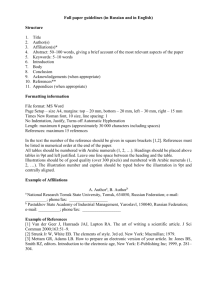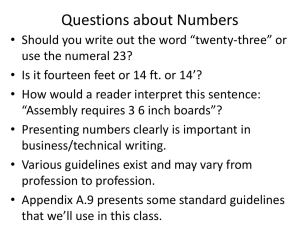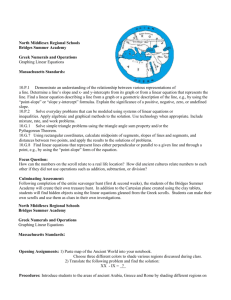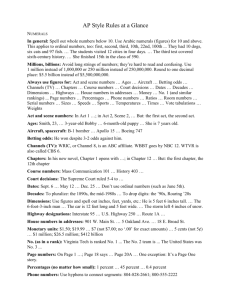The Story of Numerals Do you remember talking about the Coming
advertisement
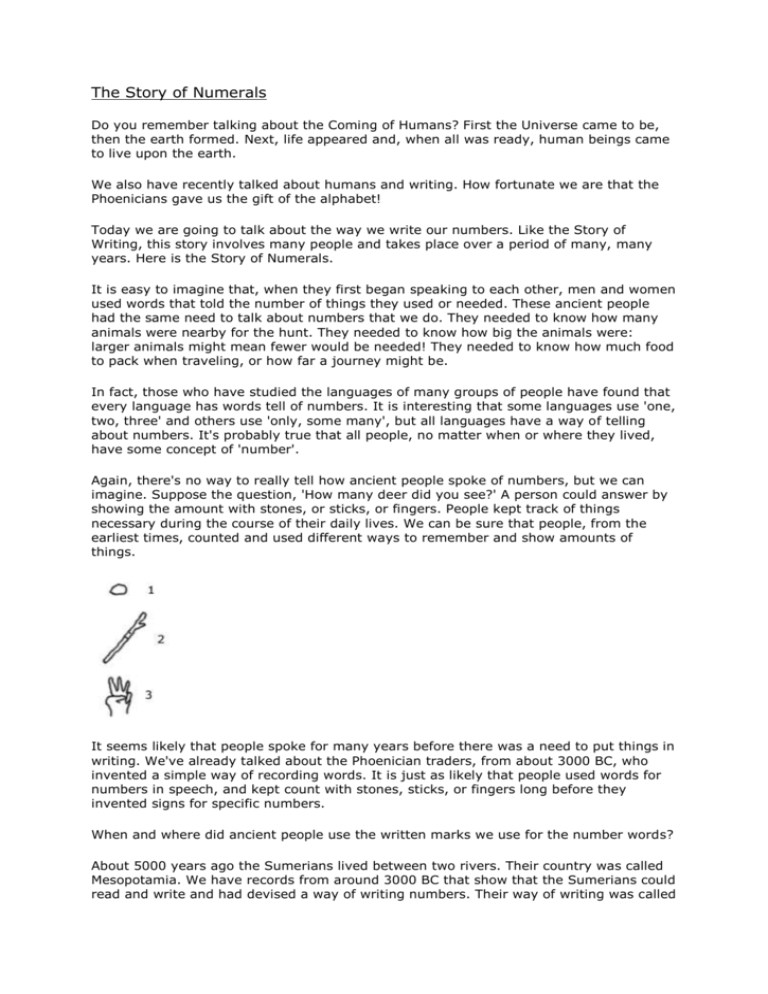
The Story of Numerals Do you remember talking about the Coming of Humans? First the Universe came to be, then the earth formed. Next, life appeared and, when all was ready, human beings came to live upon the earth. We also have recently talked about humans and writing. How fortunate we are that the Phoenicians gave us the gift of the alphabet! Today we are going to talk about the way we write our numbers. Like the Story of Writing, this story involves many people and takes place over a period of many, many years. Here is the Story of Numerals. It is easy to imagine that, when they first began speaking to each other, men and women used words that told the number of things they used or needed. These ancient people had the same need to talk about numbers that we do. They needed to know how many animals were nearby for the hunt. They needed to know how big the animals were: larger animals might mean fewer would be needed! They needed to know how much food to pack when traveling, or how far a journey might be. In fact, those who have studied the languages of many groups of people have found that every language has words tell of numbers. It is interesting that some languages use 'one, two, three' and others use 'only, some many', but all languages have a way of telling about numbers. It's probably true that all people, no matter when or where they lived, have some concept of 'number'. Again, there's no way to really tell how ancient people spoke of numbers, but we can imagine. Suppose the question, 'How many deer did you see?' A person could answer by showing the amount with stones, or sticks, or fingers. People kept track of things necessary during the course of their daily lives. We can be sure that people, from the earliest times, counted and used different ways to remember and show amounts of things. It seems likely that people spoke for many years before there was a need to put things in writing. We've already talked about the Phoenician traders, from about 3000 BC, who invented a simple way of recording words. It is just as likely that people used words for numbers in speech, and kept count with stones, sticks, or fingers long before they invented signs for specific numbers. When and where did ancient people use the written marks we use for the number words? About 5000 years ago the Sumerians lived between two rivers. Their country was called Mesopotamia. We have records from around 3000 BC that show that the Sumerians could read and write and had devised a way of writing numbers. Their way of writing was called cuneiform (wedge-shaped) because they used a stick which, when pressed into clay tablets, made wedge-shaped marks. There was another group of people, the Babylonians, who lived a bit later than the Sumerians, but who also used cuneiform writing. The Babylonians also lived in the same river valley. They used this method of writing because the clay used for making their clay tablets was plentiful. There are two reasons why we have records of the number writing of the Babylonians. The first is that they were merchants and traders, so they kept and stored many, many records. The second is that they lived in a dry, hot part of the world. Their clay tablet records dried hard in the hot sun, and stayed that way for centuries. We also have records of number writing by the Egyptians, a people that lived around the same time as the Babylonians and who were also merchants and traders. Do you remember talking about their picture writing, called hieroglyphics? An interesting thing about the Egyptians is that they had specific pictures for very large numbers. They even had a picture for 'million'! It was something like this: (open your arms upward) This represented a person who was astonished, almost like the way you would say, 'Wow!'. Perhaps they were very good merchants. Now the Greeks, who lived a bit later, did something else altogether. They used the first letters of their number word names to write the actual number. For example, the Greek word for five is 'penta', and so five was written as the Greek letter pi (write the symbol pi). The Romans also used some first letter symbols, but they also invented other signs. For example, they wrote 'X' for 'ten'. Perhaps this sign came from crossing the thumbs of both hands. Notice how crossed thumbs look like an 'X'. (demonstrate) The Roman way of writing numbers is the way that the merchants of Europe used until the 18th century. This probably so because addition and subtraction are very simple with Roman numbers and the merchants didn't want to complicate things. It is interesting to note that the Babylonians, Egyptians, Greeks, and Romans used the same symbol for the number '1', almost the same way we do: Remember that this is a story about when and where the symbols we use for numbers came to be. What about the rest of the symbols for number words, the numerals you have traced with the sandpaper letters? The first records that match the way we write our numerals were found in India, used by the Hindu people. The signs were found carved into the wall of a cave more than 2000 years ago! 'Zero' was not one of these signs. (Records do show that the Hindu people invented a sign for 'zero' about 1000 years later.) The question is: How did these symbols get from India to us? We know that people from India traded with people from a land called Arabia. The merchants who traveled from India very likely brought their way of recording numbers with them. But the people who lived in Arabia did not need a way to record numbers. They already had their own way, including a symbol for 'zero'. Why would they change their way if it worked for them? Nevertheless, there was an Arabic scholar who thought that the Hindu way of recording numbers was clever and useful. He wrote a little book about it that found its way into Europe about 1000 years ago. We know this because European writing has been found, using these same signs, in a hand-written paper dated 976 AD. Since the book came from Arabia, the symbols were called Arabic Numerals. We have records to show that these curved Arabic Numerals were copied by hand for many years. Merchants continued to use Roman Numerals, though, perhaps because they were made with straight lines and errors were not likely. There was another reason to continue using Roman Numerals, which still had no 'zero'. Merchants used counting frames for adding and subtracting and therefore did not need a 'zero'. 'Zero' simply meant that no bead was moved on the counting frame. As time passed, though, more and more records came to be written and so a 'zero' became necessary. How else could the merchants tell if a '1' meant one, or one hundred, or one thousand or more? With the arrival of the printing press in Europe, around 1450 AD, there was a smaller chance of mistakes occurring in printed records. The 'zero' made it possible to write any number, and to be sure what the number meant. Thereafter, the people of Europe began to use Arabic Numerals. There is a hand-written document dated 1442 AD which has numerals written almost the same way we write them. Numeral symbols have not changed much since that time. This is the story of how the writing of numerals came to us.
